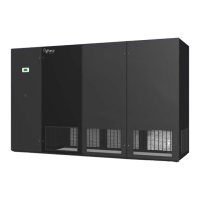29
Refrigerant Discharge Head Pressure
R-410A 350 PSIG (2.41 MPa) or higher
R-407C 230 PSIG (1.59 MPa) or higher
Remove any blocks that may have been used on the condenser coil. If the ambient temperature is
below 70°F (21⁰C), some of the refrigerant will be backed up in the condenser coil causing the liquid
level in the receiver to drop (this is normal).
Units with remote condensing units (GHCU), the superheat should be 20 to 25
o
F (11.1 to 13.9
o
C) at the
compressor.
5.4 Water/Glycol System
5.4.1 Water/Glycol Cooled System Charging
All water/glycol cooled units are factory charged with refrigerant. The superheat at the compressor
suction line at least 6 inches (152 mm) away from the compressor. The unit should be allowed to
stabilize for several minutes before meaningful measurements can be taken and the conditioned room
should be or near the temperature set-point. The water regulating valve should be adjusted to maintain
the following conditions:
Refrigerant
Discharge Head
Pressure
Saturated Suction
Pressure
Superheat
R-410A 340 to 390 PSIG (2.34to 2.69 MPa)
107 PSIG (0.74 MPa)
or greater
8 to 15°F
(4.4 to 8.3°C)
R-407C 230 to 260 PSIG (1.59 to 1.79 MPa)
72 PSIG (0.50 MPa)
or greater
8 to 15°F
(4.4 to 8.3°C)
Field charging of water/glycol systems should be done by referring to the unit’s electrical nameplate.
The factory charge is indicated on the nameplate. Although this gure represents the initial factory
charge, it is still necessary to measure and note proper unit operation including superheat, head and
suction pressures.
All water/glycol cooled units have a water regulating valve. The water regulating valve sensing port
is connected to a Schrader tting on the discharge line and water is regulated into the condenser coil
(plate n condensers are standard).
WARNING: Before starting a compressor, the crankcase heater should be energized for
a minimum of 12 hours to reduce the possibility of liquid slugging on start-up. Failure to
energize the crankcase heater could result in compressor damage.
Note: Charging to a full liquid line sight glass should never be the sole means of
determining the correct refrigerant charge. Other parameters such as superheat, suction
pressure, head pressure, sub-cooling and ambient temperature are also important. A
system charged to a clear sight glass is often overcharged.

